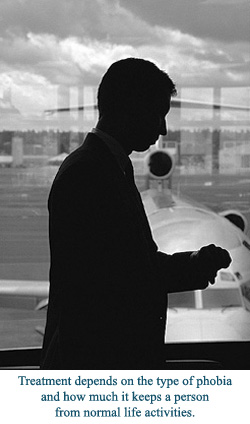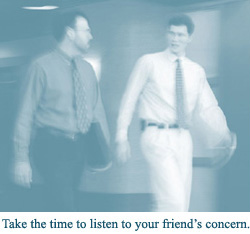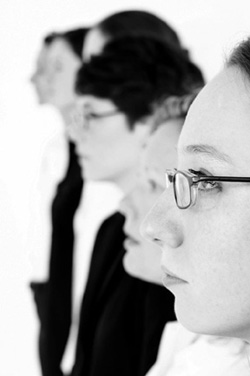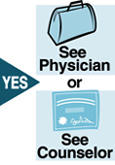Phobias - 3 Basic Types
 |
Specific Phobias. These
are sometimes called simple phobias. The irrational fear is of
specific objects, such as snakes, dogs, closed spaces or heights.
(See box below for some common phobias and their uncommon names.)
|
|
Phobia Name: |
Fear
of: |

Most of the time, simple phobias develop during childhood and
often go away with time. Those that continue into adulthood
rarely go away without treatment. |
| Acrophobia |
Heights |
| Arachneophobia |
Spiders |
| Asterophobia |
Thunder |
| Ceraunophobia |
Lightning |
| Claustrophobia |
Enclosed spaces |
| Hydrophobia |
Water |
| Mysophobia |
Dirt, Germs |
| Ophidiophobia |
Snakes |
| Nyctophobia |
Darkness |
| Pyrophobia |
Fire |
| Xenophobia |
Foreigners, Strangers |
| Zoophobia |
Animals |
 |
Social Phobia.
The irrational fear is of being embarrassed or humiliated in
public. Examples of situations leading to this include:
|
 |
Agoraphobia. The
irrational fear is of being alone in public places from which the
person:
-
Feels trapped with no way to escape (or thinks it would be
difficult to escape)
-
Would be very embarrassed or helpless when phobic symptoms
occur
-
Fears being totally unable to take care of himself or
herself if help was not around
|
Agoraphobia can occur with or without panic disorder. (See “Panic
Attacks”.) It most often comes after having panic attacks because the
sufferer avoids the places where panic attacks occurred. He or she fears
that something about the location caused the panic attack. The fear of
having another panic attack can result in avoiding going out in public. In
severe cases, persons with agoraphobia don’t leave their home at all.
Treatment
 |
Behavior therapy. One
type is called exposure therapy. This type exposes the person to the
feared situation or object in one of two ways: |
- Gradual exposure.
This is called “Systematic Desensitization.” A therapist works
with the person in gradual steps. First the person learns
relaxation methods to deal with the physical responses to his or
her phobia. Second, the person imagines the source of the
phobia. Next, the person looks at pictures of the feared object
or ones that depict the feared situation. Finally, the person is
gradually exposed to the situation or feared object.
- Direct exposure.
This is known as “Flooding.” The person is exposed to the feared
object or situation all at once (in the presence of a
therapist). The person stays in that situation until his or her
anxiety is markedly less than its previous level. Sessions doing
this are repeated until the person can handle the phobic
situation alone.
 |
Eye Movement
Desensitization and Reprocessing (EMDR). This
treatment method integrates elements of many effective
psychotherapies in combination with eye movements or other
forms of rhythmical stimulation. It stimulates the brain’s
information processing system to help clients identify,
neutralize, adapt to or resolve upsetting memories of a
traumatic event.
|
 |
Group therapy and/or
self-help support group therapy such as Agoraphobics
in Motion (A.I.M.).
|
 |
Medication.
Types include certain anti-depressants, anti-anxiety
medicines, tranquilizers and ones known as beta-blockers.
These medicines block or reduce the panic symptoms that come
with phobic situations. In so doing, they help a person
confront the feared situation when they might have been too
afraid to do so otherwise.
Medications are especially helpful for persons with
agoraphobia with panic disorder. Certain beta-blockers can
be useful for persons who suffer from stage fright. |
|
 |
Questions to Ask
Self-Help
The following tips are ways to deal with phobias that do not
disrupt your daily life. They may also be used with or after
professional treatment.
 |
List your irrational fears.
Writing them down helps you to identify them. Try to figure
out why you have the fears, what you think they mean, what
they might symbolize and what you can do to deal with them.
Doing these things can give you some control over your
fears. |
 |
Learn and practice relaxation
techniques. These allow you to feel more comfortable and
show that you can control the physical symptoms which result
from your phobia. They also help you to overcome your phobia
by allowing you to remain in the situation long enough to
realize that you are not in any danger. Two important
relaxation techniques to use are:
- Controlled Breathing. When you panic,
you over-breathe or hyperventilate which makes you
dizzy. This causes your heart to race and makes you feel
weak and tremble. Take a few deep breaths and hold each
one to the count of 3, then exhale slowly to the count
of 3. This will help restore normal breathing, slow your
pulse and remedy your dizziness and shakiness.
- Tension Control. When you panic, you
tense your muscles making them feel hard and
uncomfortable. Concentrate on each muscle group (arms,
legs, neck, shoulders) and consciously relax them until
you feel the tension subside. Practice this technique
until you can relax your muscles simply by “thinking”
about relaxing them.
|
 |
If you have a fear of speaking
in public, enroll in a public speaking course, such as Dale
Carnegie or Toastmasters. |
 |
The “Now
Awareness Technique” can be used to overcome a phobic
reaction. |
 |
If you are afraid of flying,
take a course designed to help people conquer this fear. |
 |
Also, see “Self-Help:
Ways to deal with panic that has limited symptoms and
duration”. |
 |
See a counselor if Self-Help
do not help you deal with your phobia on your own. |
|
 |
What You Can Do for a Friend or Relative
 |
Be supportive. Take their
phobia seriously. A phobic person suffers an intense fear of
something you most likely find harmless. Telling them they
are being “silly” or “childish” will not help them. It will
only serve to increase their feelings of anxiety and
alienation. |
 |
Do not attempt “flooding” on
your friend or relative. Forcing your friend or relative
into a direct, sudden confrontation with their feared
object, person, situation, etc. will only intensify their
panic and physical distress. Only a trained professional
should use this method. |
|
 |
|









